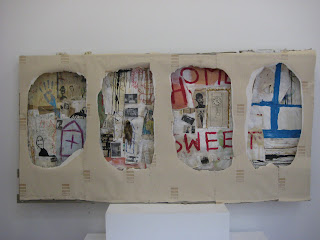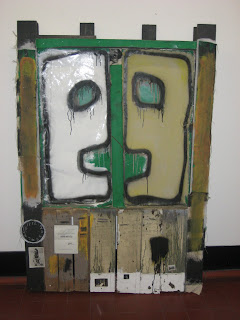




Installtion: Wallpaper, Carpet, Wood, Magazine/Newspaper Cut Outs, Colouring In Books, Power Socket, Tyres, Tin Cans, Ladders, Wire, Photgraph, Model, Chair, Paint Pots, Nails, Door, Pencil, Coffee, Wine, Ink, Dirt, Rust, Hair, Dust, Paint.
'Home Sweet Home' was a really important piece for me, as it reflected a lot of the thoughts and feelings that I felt at the time, but also revolutionized my approach to my work. I had only recently discovered Allan Kaprow, who's work really opened my eyes in terms of what art can be and how we can bring art and life closer together. Kaprow believed that art was life and that life was art. Through his work, he tried to show people the world that was going on around them, even the minute and mundane. At this point, I had only really encountered his enviroments, without much knowledge about his happenings, interventions and actions (this I would later go on to discover). His 'unart' style really jumped out at me, I loved how he would use materials that were considered to be waste, or expendable. For me, this made the work more accessible, as it was objects that we all used and had some relation to. Also, the fact that people were invited to enter the work, become submerged by it and part of it was really interesting, as I favour this approach to that of having to stand back from a piece and be scared to touch it or even go near it.
I drew meanings from previous works, like 'Broken Home' and 'Twin Memories', where I wanted to focus on personal experiences and memories. My home situation had changed drastically over the period of a year, and I soon began to find that my studio space felt more like my 'home' than anywhere else. The fact that, this 'space' was not technically my own, as it belonged to the Edinburgh College of Art, and there were rules and regulations about what I could do to the space was something that affected me. The matter of ownership was what I wanted to try and communicate. I wanted to tell everybody that this was my home and there was nothing that they could do to alter that, almost like a squatter.
I began by gathering materials that I could find, which I would be able to make a home out of. Such things like, wallpaper, carpet, a door and photographs. Then I wanted things that made the space homely for me, such as tyres, ladders, tin cans, paint pots and other such materials. I then began to make my home by covering the walls with wallpaper, posters, drawings, paint and writings. The writings were of personal thoughts and feelings, trying to in a sense stamp myself upon the space. The floor I covered with carpet and wooden planks, trying to make it comfortable for myself and taking the conceptual design of a home into consideration. It all came together to create a space that felt more like home for me than anywhere had before, in it I felt safe and relaxed. At home. Once finished and satisfied with the piece, I held a 'house warming/party', where I invited people to come into my home and look at the piece more closely, all the while trying to make them feel at home.
It was a sad day when I had to 'move out'. The funny thing was that when I cleared the space, you could clearly see the ruins of what had been my home. It had stains of my decoration and still had the more important aspect that it held memories for me that no one could take away from me.












































